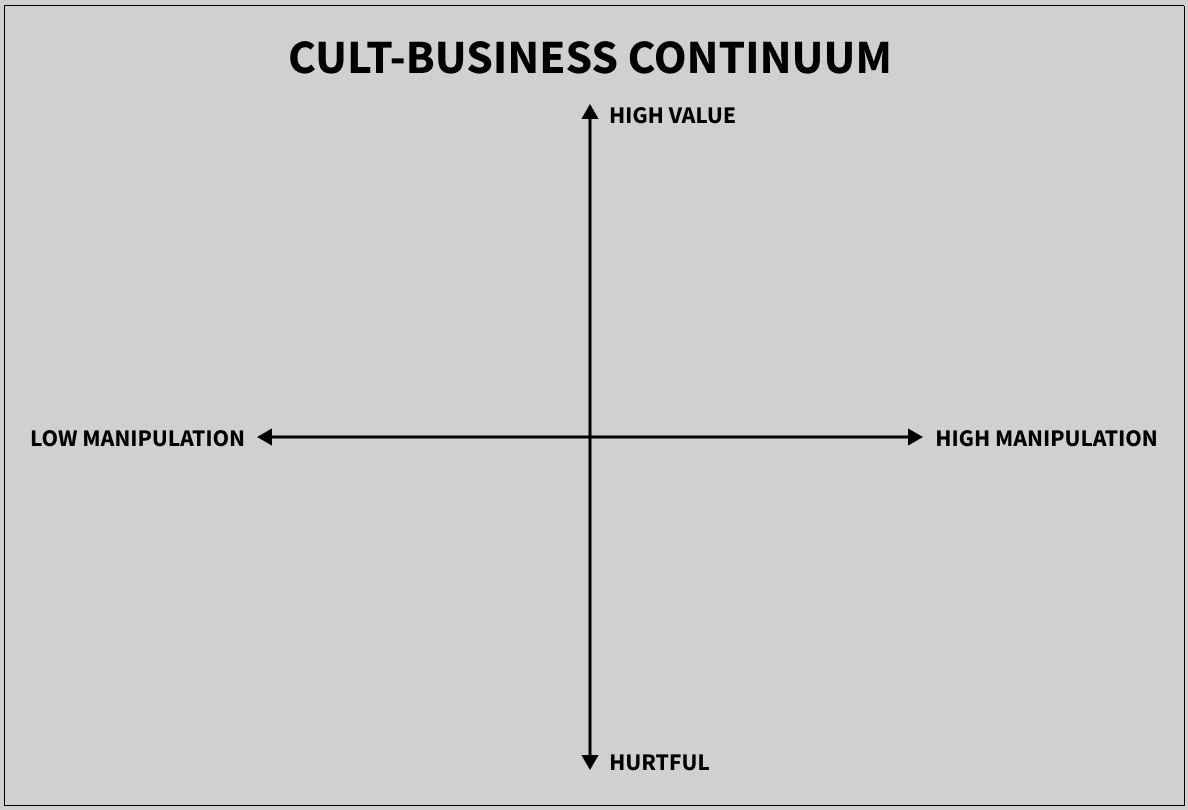The Framework For Control
My days of scrolling, shopping, or simply existing without a care in the world are a thing of the past.
The marketer in me has “poisoned the well”. Simple moments in my day-to-day life, like wandering through the grocery store and doom scrolling, are no longer casual, mindless experiences. More and more, I catch myself maneuvering through minefields of manipulation. Every ad, collab, logo, loyalty program, and promo email has a hidden agenda behind it. My sixth sense extends well beyond digital experiences too, it’s honestly harder to turn off when I’m out and about in the real world. I’m constantly analyzing how branding, packaging, and even the way a product is displayed are calculated moves in the game of marketing.
“All science is merely a means to an end. The means is knowledge. The end is control.”
Then came the cult content.
Lately my algorithm’s been feeding me cult related content from creators like Soft White Underbelly, Tommy G, and Scientology Audit (Streets LA). The more I watched, the louder my marketing brain would scream. Businesses aren’t the only ones trying to influence people! Cults are leveraging eerily similar tactics. They’re an unexpected cheat code for understanding consumer behavior.
That’s what led me to create what I’m calling the “Framework for Control”. Think of it as a thesis. NOT the academic kind, but the introductory kind that launches a much deeper analysis. Future research in this series will explore specific tactics, brand case studies, and the blurred lines between community and manipulation. There’s something about the way people are sold to and manipulated that I refuse to ignore.
Before we can zoom in on the game, let’s look at how it’s played.
THE FRAMEWORK FOR CONTROL
-
CULT: Charismatic, often seen as divine and infallible.
BUSINESS: CEO/Founder, often idolized but answers to shareholders or boards.
-
CULT: Singular spiritual truth or philosophy, often unverifiable.
BUSINESS: Mission statement or slogans that are tied to growth, innovation, or service.
-
CULTS: Promises of transformation/salvation, love bombing, and gradual indoctrination.
BUSINESS: Advertising, affiliate marketing programs, and emotional brand storytelling.
-
CULTS: High group cohesion and shared identity reinforced by suppressing any opposition.
BUSINESS: Loyalty programs, insider perks, customer forums, and brand ambassadors.
-
CULTS: New definitions for existing words, euphemisms, and chants that reinforce in-group/out-group dynamics.
BUSINESS: Product names, buzzwords, jingles, and branded terms used to build identity.
-
CULTS: Tiered levels of access.
BUSINESS: Subscription tiers, membership levels, and career ladders.
-
CULTS: Ceremonies, blood oathes, ritualistic scarring, and symbolic sacrifices.
BUSINESS: Brand activations, product launches, conferences, and shareholder calls.
-
CULTS: Isolation, behavior monitoring, emotional manipulation, and fear of leaving.
BUSINESS: Data-driven personalization, planned obsolescence, non-compete agreements, NDAs, and “golden handcuffs”.
-
CULTS: Donations, tithes, and mandatory purchases for spiritual advancement.
BUSINESS: Selling products and services, often with upsells.
-
CULTS: Uniform dress, shared slogans, symbolic visuals.
BUSINESS: Branded merch, social media voice, brand guidelines, corporate dress codes.
-
CULTS: Disconnection from family, emotional exile, fear, and psychological damage.
BUSINESS: Social backlash, loss of perks or status, exit interviews, and alumni networks.
Whether you’re being asked to drink the Kool-Aid or sign up for a loyalty program, both cults and corporations rely on the same structured system to control behavior, belief, and belonging. The lines start to blur somewhere between spiritual awakening and product launch, but the intent to control remains eerily familiar. This grey area is where marketing strategy slips into something more psychological, and where the Cult–Business Continuum begins to take shape.
CULT-BUSINESS CONTINUUM
If the Framework for Control explains how influence works, the Cult–Business Continuum shows where that influence lands. Picture a simple four-quadrant graph. The x-axis measures the level of manipulation, while the y-axis measures the value delivered to the end user. Together, they reveal a spectrum where any product, industry, or organization can be plotted.
Top Right (High Manipulation / High Value) - Where luxury brands and aspirational products live. They engineer scarcity and status, but also return value through resale or prestige. Brands like Rolex, Supreme, and Apple live here.
Bottom Right (High Manipulation / Hurtful) - This is where things turn predatory, utilizing heavy psychological levers and harmful outcomes for the end user. Big tobacco and casinos are mild examples, while actual cults like Heaven’s Gate and Jonestown are extreme examples.
Top Left (Low Manipulation / High Value) - Straightforward utility that improves life without much trickery. Groceries, healthcare (for the most part), and educational tools would all live in this quadrant.
Bottom Left (Low Manipulation / Hurtful) - Commodity wasteland! Mild examples would be candy, fast fashion, and scratch tickets. Extreme examples would be payday loans, rent-to-own furniture, and street-level drugs.
Keep in mind that none of this is an exact science, the continuum simply reflects my perspectives. What looks like manipulation to one person might feel like community to another. Someone’s exploitative OnlyFans is someone else’s paycheck. Scarcity in luxury goods can be a scam or a store of wealth, depending on how you frame it. The point isn’t to find a “right answer”, but to recognize how blurry the line really is between cult and company.
None of us are immune to these games, myself included. The only difference is whether you’re a pawn on the board or learning to study the board itself. Follow along for future case studies in this series, thanks for reading!


